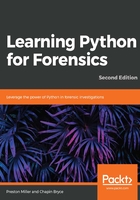
Now for Something Completely Different
This book presents Python as a necessary tool to optimize digital forensic analysis—written from an examiner's perspective. In the first two chapters, we introduce the basics of Python in preparation for the remainder of this book, where we will develop scripts to accomplish forensic tasks. While focused on the use of the language as a tool, we will also explore the advantages of Python and how they allow many individuals in the field to create solutions for complex forensic challenges. Like Monty Python, Python's namesake, the next 12 chapters aim to present something completely different.
In this fast-paced field, a scripting language provides flexible problem solving in an automated fashion, allowing the examiner additional time to investigate other artifacts that, due to time constraints, may not have been analyzed as thoroughly otherwise. Admittedly, Python may not always be the right tool to complete the task at hand, but it is an invaluable tool to add to anyone's DFIR arsenal. Should you undertake the task of mastering Python, it will more than pay off the time investment as you will increase your analysis capabilities many fold and greatly diversify your skill set. This chapter outlines the basics of Python, from Hello World to core scripting concepts.
This chapter will cover the following topics:
- An introduction to Python and healthy development practices
- Basic programming concepts
- Manipulating and storing objects in Python
- Creating simple conditionals, loops, and functions